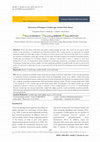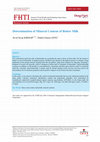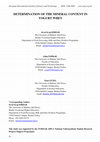Papers by Seval Sevgi Kirdar

Mehmet Akif Ersoy Üniversitesi Sağlık Bilimleri Enstitüsü Dergisi, 2018
Yeasts may affect food safety and quality causing spoilage in foods. Also, yeasts can be used as ... more Yeasts may affect food safety and quality causing spoilage in foods. Also, yeasts can be used as starter culture in the production of traditional and industrial products. Candida species are important for hospital infections which have been able to infect to humans via food in recent years. The aim of this study was to evaluate the incidence of pathogen Candida spp. in butter. In this study, 100 butter samples were analyzed from public bazaars. Candida spp. was detected 10 % of butter samples. C. albicans, C. albicans and C. krusei, C. tropicalis, C. krusei were isolated 4%, 3%, 2%, 1% from Candida spp. positive butter samples, respectively. According to this data, presence of pathogen Candida spp. in butter samples can cause significant problems in public health. In order to ensure food safety, it is necessary to determine the rate of yeast and mold and the detection of pathogen yeasts in microbiological analyses.
Süleyman Demirel Üniversitesi Fen Bilimleri Enstitüsü Dergisi, 2000

Food Health and Technology Innovations, Sep 30, 2019
The composition and food value of buttermilk are essentially the same as those of skim milk. The ... more The composition and food value of buttermilk are essentially the same as those of skim milk. The fat content is higher in case of buttermilk. It supplies protein, riboflavin and calcium in the highest amount. It contains a large proportion of the protein mixture slouched from the fat globule-milk serum interface by churning. Churning 1 kilogram of cream will typically yield 0.5 kilogram of butter and 0.5 kilogram of buttermilk. Liquid buttermilk is prone to oxidation, so this product is concentrated by evaporation and then sprays dried in order to extend the shelf life. Currently, dried buttermilk is mainly used for animal feeding (swine, bovine), but also used in the food industry for its emulsion properties and its positive impacts on the texture and taste of products. Conclusion : In this study, it was aimed to determine the content of minerals buttermilk that uses the traditional method in the dairy plants. Calcium, potassium, phosphorus, sodium and magnesium quantities were determined by simultaneous inductively coupled plasma optical emission spectrometry (ICP-OES). In the butter milk, the

Strained yogurt is an indispensable flavor of traditional Turkish and Anatolian food culture, and... more Strained yogurt is an indispensable flavor of traditional Turkish and Anatolian food culture, and one of its oldest and most important elements. The basic principle of strained yogurt production is to reduce the water content and increase product longevity by removing the serum. This study aims to determine the mineral content in yogurt whey, one of the main pollutants in the dairy industry. Calcium, potassium, phosphorus, sodium and magnesium quantities were determined by simultaneous inductively coupled plasma optical emission spectrometry (ICP-OES). In these samples, Ca was 934±130mg/L, Mg was 969±257mg/L, K was 1257±159, Na was 940±104 mg/L, and P was157±23mg/L. Therefore, the pollution caused by the organic load of yogurt whey when it is discharged into the environment can be prevented, and yogurt whey can be used as auxiliary matter in production of dairy products and other nutrients by recycling its nutrients using technological methods, as is done with cheese whey.
Journal of Food Processing and Preservation
Current Developments in Food and Nutrition Research, 2020
SILVA, Maria Aparecida Alves da. Manumission by sensitive: corporeality of the child and teacher ... more SILVA, Maria Aparecida Alves da. Manumission by sensitive: corporeality of the child and teacher training. 2013, 254sh. Thesis (Ph.D. Education)

In this study, the effects of I².D. Galactosidase enzyme preparation which was used in yoghurt ma... more In this study, the effects of I².D. Galactosidase enzyme preparation which was used in yoghurt manufacturing on some quality criteria of the final product, were investigated. By adding 0.1 ml, 0.2 m1 and 0.3 ml enzyme to 1 liter of milk, approximately 30%, 50%, 70% and 90% hydrolysis of lactose were achieved, respectively. In yoghurt samples, obtained by adding enzyme to milk, coagulation time, consistency, titratable acidity, acetaldehyde content and level of tyrosine as well as organoleptic properties were determined during the first and 14 days of storage. Titratable acidity and consistency of yoghurts was not affected by the process of hidrolysis. While acetaldehyde and tyrosine con-tents of the enzyme-treated samples increased. During the storage period, an increase in the level of tyrosine was observed a decrease in the contents of acetaldehyde was found on the contrary. According to the overall score, yoghurt samples, manufactured by hydrolysis, 50% (A) and 70%(B) lactose was...
International Journal of Agriculture and Environmental Research, 2021

Agriculture and Food, 2016
Dairy products have been very important components in the Turkish diet for centuries especially c... more Dairy products have been very important components in the Turkish diet for centuries especially cheese which is a principle food and a tradition for breakfast. Traditional dairy products are becoming more popular in Turkey due to the turning back to the " natural alimentation ". They are differing between regions in Turkey according to the geographical location, cultural differences and traditional customs and values. Many factors are influencing the consumption of traditional dairy products such as; migration of the people from rural to urban areas, nostalgia, renewal of the nutrition habits, agro-turism, interest on products of free from additives. Most of the traditional products is produced only in the rural areas and some of them are about to be forgotten. Lack of the interdisciplinary collaboration between farmer, producer and the consumer triangle, hygienic and sanitary conditions in the production and storage conditions constitute the main problems. In the Hatay province of Turkey is mainly processed into some traditional dairy products such as; Salted yoghurt, Carra cheese, Surk cheese, Künefe cheese, Sünme cheese, Hatay Dil cheese, Ezme cheese. The aims of this review were to introduce traditional dairy products produced in the Hatay province of Turkey and to characterize the processing stages and to describe their compositional characteristics.

Gida the Journal of Food, 2003
In this study, total salt, fat contents, total bacteria, coliform and E. coli counts were determi... more In this study, total salt, fat contents, total bacteria, coliform and E. coli counts were determined for 35 samples of vanillin ice cream and 15 samples of chocolate ice cream which were sold from different pastry shop in Burdur Turkey. None of the samples complied with the legal requirement for chemical values and bacteriological counts. Vanillin ice cream respectively had total sold and fat values of 67.71%, 14.28% and 15 samples of chocolate ice cream respectively 78.57% and 28.57% below the limits set by ice cream standard. It was found that 28.57% of vanillin and chocolate ice cream of the samples had a total bacteria, count g 100 000/g while 62.85% of vanillin ice cream samples and 28.57% chocolate ice cream samples had g 100 coliform bacteria/ g. In addition E. coli was determined in 6 samples of vanillin ice cream and one of the chocolate ice creams. As a result, the chemical and bacteriological quality of ice cream which was consumed in Burdur determined to be unacceptable.
Journal of Food Processing and Preservation, 2021

Gida the Journal of Food, 1999
Bu calismada, “Dayanikli Ayran” uretiminde pektin’in farkli kullanim oranlari denenmis ve elde ed... more Bu calismada, “Dayanikli Ayran” uretiminde pektin’in farkli kullanim oranlari denenmis ve elde edilen ayranlarin bazi kalite kriterleri, geleneksel yontemle uretilen ayranla karsilastirmali olarak incelenmistir. Pektin kullanim oranlarinin belirlenmesinde literaturlerde verilen degerler esas alinmistir. Ayran ornekleri, yogurttan (i) geleneksel yontemle ve (ii) %0.2 (iii) %0.4, (iv) %0.6 ve (v) %0.8 oranlarinda pektin ilavesiyle uretilmistir. Geleneksel yontemle uretim, yogurda yalnizca tuz ve su ilavesiyle gerceklestirilmis, diger orneklerin uretiminde ise yukarida oranlari belirtilen pektinle birlikte tuz ve suyun karisimindan yararlanilmistir. Izleyen asamada, pektin katkili orneklere homojenizasyon (150-200 kg/cm2/50 oC) ve isil islem (60-65oC/5-10 dakika) uygulanmis, daha sonra, butun ornekler aseptik kosullarda ambalajlanmistir. Ayran orneklerinde, depolamanin 1., 15., 30., 45. ve 60. gunlerinde, titrasyon asitligi, pH, laktik asit, asetaldehit, tirozin, viskozite ve serum ayr...

In this study, the composition and microbiological properties of 40 strained yoghurt (Concentrate... more In this study, the composition and microbiological properties of 40 strained yoghurt (Concentrate Yoghurt) samples obtained from Burdur market was determined and the results were compared with Food Regulation The total solids content in all strained yoghurt were ranged from 12.93% to 34.59 %, with the main of 21.90% According to the results of tat content 55% of the samples are classified into whole fat type, 37.5% of the samples are classified into half fat type and 17.5% of the samples are classified into non-fat. The mean for the values protein, lactose and ash contents of strained yoghurt were 12.55%, 3.07% and 0.70% respectively. Titratable acidity of the samples were between %1.13 (50 °) - %2.40 (106.75° SH) and 97.5% of samples were found to be consisted with Food Regulation. pH values were ranged from 3.88 to 3.41, with the mean of 3.69. According to the microbiological results, it was showed that strained yoghurt produced under the poor hygienic conditions.

Gida the Journal of Food, 2001
Arastirmada secilen dort isletmede (A, B, C, D) iki zaman periyodunda (Kis ve Yaz Aylari) uretile... more Arastirmada secilen dort isletmede (A, B, C, D) iki zaman periyodunda (Kis ve Yaz Aylari) uretilen suzme yogurtlarinin uretim teknolojisi belirlenmistir. Arastirmada isletmelerdeki suzme yogurt uretim teknigi yerinde incelenmistir. Suzme yogurt uretiminde kullanilan cig sutlerin toplam kurumaddesi % 10.79 -11. 82, yag orani % 3 - 3.6, protein icerigi % 2.19 - 3.8, laktoz % 3.41 - 5.41, mineral madde miktari % 0.37 - 0.68 ve titrasyon asitligi (°SH) 5.92 - 7.86 arasinda bulunmustur. Isletmelerde uretilen suzme yogurtlarin toplam kurumaddesi % 18.00 - 26.96, yag oram % 6.0 -10.4, protein icerigi % 4.46 - 9.22, laktoz % 4.06 - 8.65, mineral madde miktari % 0.56 - 0.82 ve titrasyon asitligi (% LA.) % 1.43 -1.95 arasinda degistigi belirlenmistir. Mikrobiyolojik analiz sonuclarina gore, toplam bakteri 1,2 x103 -1x108 adet/ gram, maya-kuf 0-3.85x105 adet/gram, koliform grup mikroorganizma 0-8 adet/gram olarak tespit edilmistir. Kis aylarinda suzme yogurt orneklerinde E. coli tespit edilme...
Indian Journal of Dairy Science, 2020

Uploads
Papers by Seval Sevgi Kirdar